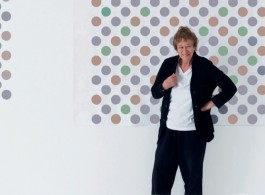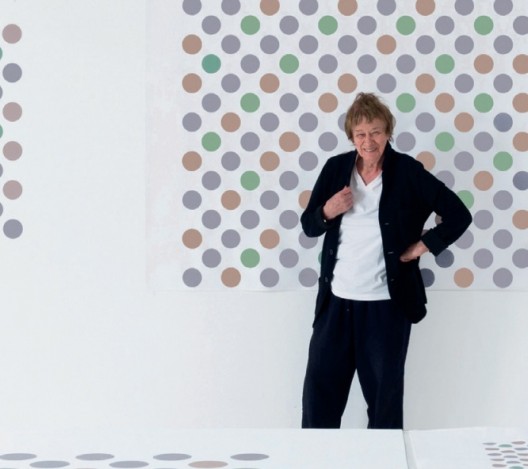David Zwirner, London
Press preview with Michael Bracewell: Thursday 18 January 2018, 10am
Private view: Thursday 18 January 2018, 6 – 8pm
David Zwirner is pleased to present recent work from the last four years by British artist Bridget Riley, her third solo exhibition with the gallery. Spanning three floors of the 24 Grafton Street location in London, the exhibition will include wall paintings and works on canvas as well as a group of related studies that focus on two themes: works in black-and-white and the disc. The works on view both extend and rework the artist’s previous investigations of these motifs in new ways.
Riley’s formally taut, abstract compositions yield a singular sense of visual pleasure for the viewer, a notion derived as much from the artist’s formative encounters with Old Master and Impressionist painting as from her early experiences with nature. Since 1961, she has focused exclusively on seemingly simple geometric forms, such as lines, circles, curves, and squares, arrayed across a surface—whether a canvas, a wall, or paper—according to an internal logic. The resulting compositions actively engage the viewer, at times triggering sensations of vibration and movement. This sense of dynamism was explored to great effect in the artist’s earliest black-and-white paintings, which established the basis of her enduring formal vocabulary. In 1967, Riley introduced colour into her work, thus expanding the perceptual and optical possibilities of her compositions. Though she has completed site-specific murals, beginning in 1983 with her work for the Royal Liverpool University Hospital, more recently, the development of Riley’s body of wall paintings, initiated in 2007 with Arcadia 1, underscores perception itself as her enduring subject. Painting directly on the wall, Riley collapses the distinction between figure, ground, and support, thus activating the picture plane in a different way from her works on canvas.
Over the course of her more than fifty-year career, Riley has frequently returned to earlier ideas and even to specific works in order to identify alternative directions that a form could take. As she has noted, “I am sometimes asked ‘What is your objective’ and this I cannot truthfully answer. I work ‘from’ something rather than ‘towards’ something. It is a process of discovery.”1 On the ground floor will be wall paintings and works on canvas in which the artist has returned to an achromatic palette for the first time since the 1960s. In particular, works such as Quiver 3 (2014) take up the motif of the triangle, first explored in Tremor (1962; Museum für Gegenwartskunst Siegen, Germany), which comprises tightly tessellated, irregular triangles that combine to create a subtle sense of undulation across the surface of a square canvas. Here, Riley revisits the equilateral triangle, but introduces a curved edge that greatly modulates the overall tenor of her composition.
The gallery’s first floor will include wall paintings and works on canvas featuring a recently inaugurated motif: discs. While new to Riley’s lexicon, these works have their basis in the artist’s Deny paintings from 1966, which feature gridded circular forms. Executed during a period when Riley was beginning to experiment with colour, in particular incorporating grey tones into her compositions as a chromatic intermediary between black and white, these works are animated by the sum effect of the interaction of colour and form. With the discs, which were first presented in the artist’s 2017 solo exhibition at Christchurch Art Gallery, New Zealand, Riley has broken open the tightly constructed grids of the 1960s, creating even more complex and nuanced structures within which individual components interact, depending on the viewer’s position. Also on view in the Upper Room will be a group of studies for this body of work. Throughout her career, Riley has extensively utilised smaller scale works as a means of arriving at her final compositions. Presented alongside larger works, these studies give crucial insight into the artist’s working method.
On the occasion of the exhibition, a new monograph on Riley is forthcoming from David Zwirner Books, featuring new scholarship on the artist by art historian Richard Shiff.




